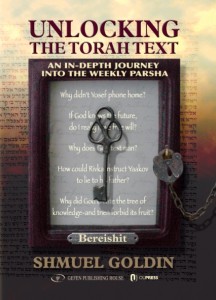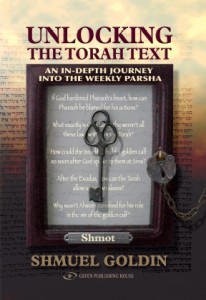Excerpted from Rabbi Shmuel Goldin’s ‘Unlocking The Torah Text: An In-Depth Journey Into The Weekly Parsha- Bereishit’
 What Place?
What Place?
Context
In the course of his journey from Be’er Sheva to Charan, Yaakov arrives at a location where he is forced to bed down for the night. There he dreams his famous dream of a ladder stretching from the earth heavenward.
The phrase used in the Torah to describe Yaakov’s initial encounter with the location of his dream is: vayifga ba’makom, “and he encountered the place.”
Questions
The text seems to be referencing a specific location of importance, already known to us. And yet the site of Yaakov’s dream is later identified in the text as the town of Luz, a location that has not been mentioned previously in the Torah and which is of no inherent significance prior to Yaakov’s dream.
Why then does the text read ba’makom, “the place” as opposed to b’makom, “a place”?
Approaches
A
Two distinct and very different approaches are offered by the rabbis in answer to this question.
1. The Midrashic approach:
The location of Yaakov’s dream was actually Mount Moriah, later to become the Temple Mount in Jerusalem.
Two generations earlier, when Avraham arrives at Mount Moriah, the site of Akeidat Yitzchak, the Torah states: Va’ya’ar es hamakom mei’rachok, “and he saw the place from afar.”
By referring to both Mount Moriah and the location of Yaakov’s dream as “the place,” the Torah connects the two sites and indicates that they are one and the same.
The Midrashic approach encounters a serious geographical difficulty. At the time of his dream, Yaakov is actually at a location which he will identify as Beit E-l (literally “The House of God”) far to the north of Jerusalem.
The Talmud addresses this difficulty by suggesting, based on textual hints, that Yaakov actually completes his entire journey and reaches Charan. The patriarch, however, then suffers remorse at having passed by Mount Moriah, “the place where his fathers prayed,” without stopping for prayer. God miraculously transports Yaakov back to Mount Moriah where he dreams his dream.
Rashi, in his commentary on the Talmud, explains that, according to this interpretation, when the patriarch names the site of his dream “Beit E-l,” he is not referring to the location identified as Beit E-l today, but to Jerusalem, which he prophetically identifies as the “House of God.” In his commentary on Chumash, however, Rashi takes a different tack. He interprets the Talmudic position by maintaining that God performed the additional miracle of uprooting Mount Moriah and temporarily bringing it to Beit E-l.
The Midrash Rabba quotes Rebbe Elazar in the name of Rebbi Yossi Ben Zimri who suggests that the ladder of Yaakov’s dream was rooted in Be’er Sheva, stretched to Beit E-l and had its center at Jerusalem.
2. The approach of pashut pshat:
As night fell, Yaakov arrived at a location outside the town of Luz.
Some authorities suggest that this location was specifically set aside for wayfarers. While it was not a site of particular significance, the Torah nonetheless refers to it as hamakom, “the place,” because of the practical purpose that it served. Similar sites existed outside other towns at that time.
B
The debate concerning the site of Yaakov’s dream might, at first glance, seem to be of only passing interest. What exactly is driving this rabbinic discussion? What compels the Midrash to perform geographic calisthenics simply to allow the dream to occur on Mount Moriah? And is there any deeper meaning to the approach of pashut pshat and its claim that the dream occurred in a location of no special significance?
C
Yaakov’s reaction, upon abruptly awakening from this dream, lends significance in retrospect to the issue at hand. Suddenly the question of the dream’s location becomes very important, indeed, striking to the core of the concept of sanctity within Jewish thought.
Yaakov exclaims: “Behold the Lord is in this place and I did not know…. How awesome is this place! This is none other than the House of God and this is the gate to heaven!”
On the basis of this observation, Yaakov subsequently renames the location Beit E-l, “the House of God.”
The interpretation of Yaakov’s words is dependent upon which position one takes in the debate concerning the location of the patriarch’s dream.
Once again, two very different possibilities emerge:
1. According to the Midrashic approach Yaakov cries out: Oh my God, look at where I am! I am sleeping on Mount Moriah, the very gateway to heaven! How could I have been so blind to the inherent significance and sanctity of this location? How could I have failed to act with greater deference?
2. According to the approach of pashut pshat, on the other hand, Yaakov’s observation is very different: I had no idea… God is everywhere! If the Lord can appear to me in a vision of such grandeur at this unimportant spot, outside the city of Luz, then every place upon which I stand is potentially the house of God and any location on earth can be the gateway to heaven.
The power of this observation is multiplied a thousandfold when we recognize that, at this point, a patriarch is about to leave the land of Canaan for the first time in over a generation. Common religious belief in the patriarchal era dictated that specific gods were tied to specific lands. Yaakov could well have been concerned, therefore, at this frightening moment of his life, that his God might offer only limited or no protection outside the land of Canaan.
As we will note in the next study (see Vayeitzei 2, Approaches e–g) much of Yaakov’s dream is tailored to disabuse the patriarch of this notion and to remind him of the all-encompassing power of the One and only God.
D
Which of the two approaches is correct? Exactly where did Yaakov dream his dream? And what is the substance of the patriarch’s observation upon awakening?
As is always the case in such rabbinic disputes, both approaches are philosophically correct. Taken together, they create the balance that defines the idea of kedushat makom, “sanctity of place,” in Jewish tradition.
On the one hand, we certainly believe in the existence of locations of inherent, overarching sanctity. The Land of Israel, Jerusalem, the Temple Mount (Mount Moriah) – these are locations which draw us with singular power, sites where our connection to God is stronger than at any other. To the mind of the authors of the Midrash it had to be the holiest of these sites, Mount Moriah, upon which Yaakov experienced his lofty vision.
On the other hand, we believe that we are partners with God in the creation of holiness wherever we may be. God is everywhere, and our ability to reach Him is not limited to a specific time or place. Kedusha (sanctity) can surprise us, appearing when and where it is least expected – outside the town of Luz or anywhere else – in a kind word, a loving gesture, a heartfelt prayer.
Elements of these two types of kedusha (sanctity) are not mutually exclusive; in fact, they clearly overlap.
Locations of inherent holiness in Jewish tradition achieve their kedusha only through the efforts of man in partnership with God. The Land of Israel, for example, was first sanctified upon the entry of the Jewish nation, and that sanctity only became permanent, according to most authorities, centuries later, when our ancestors returned from Babylonian exile. Even the holy Temple became sacred through the participation of man.
On the other hand, while we are enjoined to create kedusha in partnership with God wherever we may be, there remains a fundamental distinction between sanctity created within and outside the Land of Israel. In the diaspora, we are enjoined to generate sanctity through our words and actions – through the way in which we live our lives – but we cannot bestow lasting kedusha upon a specific location. Outside the land, such sanctity remains temporal and fleeting; it dissipates once our efforts cease and our presence ends. Only in the Land of Israel does the possibility of permanent kedusha exist. Once sanctified properly, the Land of Israel retained its holiness even when our people were exiled beyond its borders. In this way, once established, our holiest sites remained a continuing beacon of inspiration to a far-flung people across a turbulent history.
A Personal Reminiscence
A number of years ago I traveled with members of my congregation to Eastern Europe prior to our annual mission to Israel. Among our experiences was a visit to the Theresienstadt concentration camp, a way station for countless of our brethren on the journey to their final destination.
At one particular location in the camp, our guide took us behind a bakery and down some steps to a hidden underground room. Suddenly we found ourselves, to our astonishment, in a small synagogue which had been built by a group of Danish Jews, secretly, under the very eyes of their Nazi tormentors. We were speechless, struck by the courage and devotion of these individuals who, at the risk of their lives, had continued to worship their Creator, even at a time when God’s very face was hidden from them.
As we walked around that small shul, we noticed that passages from the Torah and liturgy had been painted on the walls in a fashion common to European synagogues of that time. One such passage poignantly read, “And in spite of all, we have not forgotten, [Dear Lord] do not forget us.”
But, then, as I continued to read, I was suddenly struck completely dumb. For on the wall before me appeared the following passage, painted through who knows how many tears: “How awesome is this place! This is none other than the House of God and this is the gate to heaven!” I was astounded… Here in Theresienstadt, the “House of God”? In the depths of hell, the “gate to heaven”?
I gazed at the words spoken by the patriarch, Yaakov, in the darkness of the night outside the town of Luz, painstakingly painted centuries later on the walls of a secret synagogue in Theresienstadt…and I felt a fleeting sense of the sanctity which had existed in that room decades earlier. A sanctity created by a courageous group of nameless Jews who understood that even in the darkness of hell, even in the presence of their tormentors, even in the depths of pain and sorrow, holiness could somehow be achieved and God could somehow be found.
Their courage and devotion will remain with me forever.




